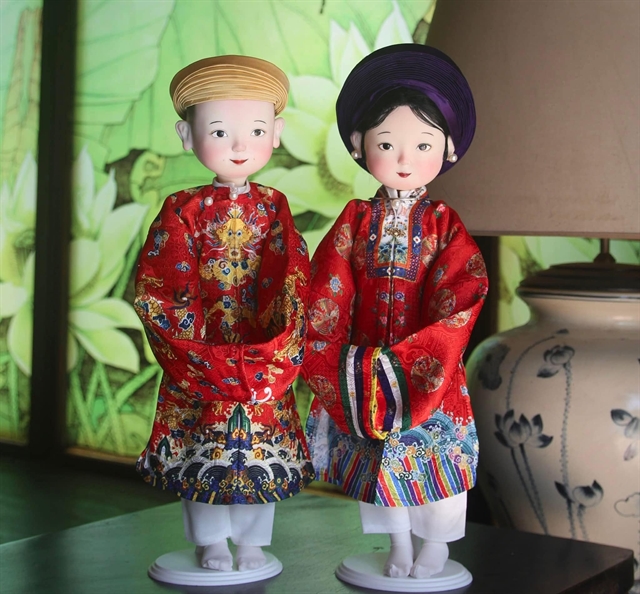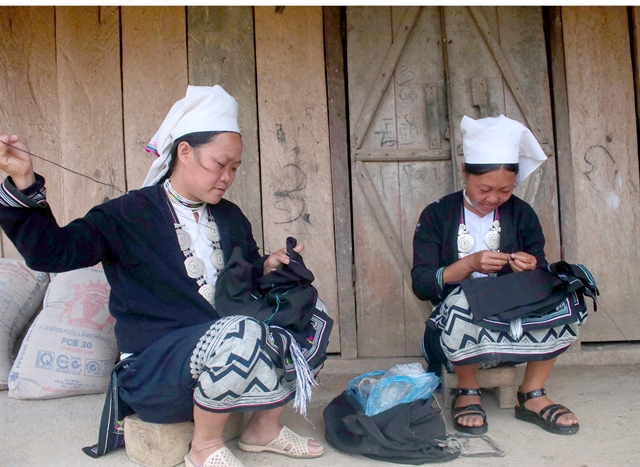 Features
Features

Wooden houses with roofs of yin-yang tiles and nestled on the side of a mountain are simple in design yet give Hoài Khao Village in the northern mountainous province of Cao Bằng a certain poetic charm.

|
| PICTURE-PERFECT: Hoài Khao Village is nestled among mountains and valleys. VNA/VNS Photo Chu Hiệu |
Wooden houses with roofs of yin-yang tiles and nestled on the side of a mountain are simple in design yet give Hoài Khao Village in the northern mountainous province of Cao Bằng a certain poetic charm.
In Quang Thành Commune, Nguyên Bình District, the village has become one of the most attractive destinations in the local area for visitors seeking community tourism in Việt Nam’s northeast region.
Tourists will be struck by the unique cultural values and traditional customs of the Dao Tiền ethnic minority, through their “páo dung” folk songs and costumes embroidered with sophisticated patterns illustrating local nature and landscapes.
Villager Bàn Thị Liên, 36, was born and raised in a wooden house typical of her grandparent’s generation, which gave her and her friends in Hoài Khao a host of unforgettable childhood memories.

|
| LOCAL QUALITY: Brocade embroidery is among the cultural identities the ethnic Dao Tiền villagers in Hoài Khao are trying to preserve. VNA/VNS Photo Chu Hiệu |
When a wooden house is built, she explained, a separate storehouse for paddy rice is also built, which is a unique cultural feature of the Dao Tiền.
“Both the house and the storehouse are precious assets of the family,” she said.
All Dao Tiền women, meanwhile, have special skills in weaving brocade and making other products.
“They are skilled in printing patterns on fabric using beeswax to make elaborate Dao Tiền outfits,” she said. “Girls from 10 to 12 years old are taught by their mothers and grandmothers to embroider patterns and gradually learn all the different techniques.”
Another special feature making community tourism viable in Hoài Khao is the bee hives found in two caves near the village.
As people are not allowed to take any honey, which protects the hives, both caves have become home to millions of bees.
They return to the hives in the spring and then fly away once autumn arrives, leaving behind a large number of wax shells that are used by local women as raw materials to make beeswax for printing on fabric -- one of the main steps in the process of creating unique patterns on traditional costumes.
Different activities and practices during the four seasons mean visitors can take in ever-changing natural beauty while experiencing unforgettable traditional and cultural experiences.
In summer, they can feel the fresh air of the mountains and admire the green rice fields under their feet. In autumn, the village looks like it’s “wearing” a brilliant dress, with yellow rice fields blanketing the valley. Visitors can also attend a worshipping ceremony held by villagers to thank the bees and to welcome their return.
There’s also fragrant local rice wine to try, and dishes containing both nutrition and culture.
They can also experience the hospitality of people in these mountainous areas, especially when they gather together by the fire and listen to stories about their lives and customs bearing the cultural identity of the Dao Tiền.
Hoàng Quốc Chấn, chairman of the People’s Committee of Quang Thành Commune, said community tourism in Hoài Khao is a key development target this year, so authorities are mobilising all local people to work together on preserving the village’s cultural values, including the protection of their wooden houses, relocating barns away from residential areas to ensure environmental sanitation, and donating part of their land so public facilities for the development of community tourism can be built.
Nông Quốc Hưng, chairman of the People’s Committee of Nguyên Bình District, said district authorities have invested over VNĐ18 billion (US$775,000) on various works to assist the community tourism programme in Hoài Khao, including upgrading roads, building new models for agricultural development, improving and creating new forms of communal cultural activities, protecting the environment, and creating new information services for tourists.
Nguyên Binh District is focusing on a programme promoting the preservation and development of folk music performances, embroidery, and knitting, and the production of handicraft souvenirs.

|
| INVITING HOMES: The wooden houses found in the area are simple yet enchanting. VNA/VNS Photo Chu Hiệu |
Hưng said the district will hold an announcement ceremony in October for Hoài Khao officially becoming a community tourism village.
The district is especially focusing on preserving the natural environment and views this as a foundation for sustainable tourism development, so has created the conditions necessary for people in Hoài Khao to protect their surroundings.
The different ethnic groups in the village recently received a Certificate of the Việt Nam Heritage Tree, for an ancient tree called Cây phát tài (Fortune Tree).
More than 200 years old, the tree has been determined by experts from the Việt Nam Association for the Conservation of Nature and Environment to be a bischofia (scientifically named Bischofia javanica).
Nguyên Bình’s remote location in mountainous Cao Bằng Province allows it to offer a wide range of fantastic off-the-beaten-track tours, such as road trips, mountain hikes, jungle treks, homestays, and community tours.
The mountainous expanse is home to many ethnic minorities and so has become a popular attraction. The local landscapes are typified by jagged mountains carpeted in thick vegetation, sporadic rice paddies, and narrow winding roads. VNS